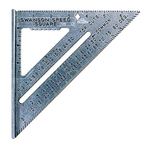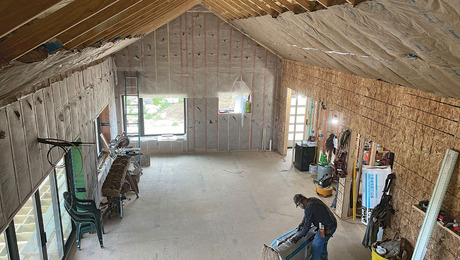Against the Grain: The Next Generation of Builders
Millennials are picking up the tool belts the generation ahead is putting down

Not only did the construction sector lose more than half of its workforce in the Great Recession, but the percentage of new hires under the age of 45 went from 73% in 2000 to 63% in 2011. Most significant was the decline of 19-to-24-year-olds, who went from 18% at the peak to 13%. These youngest job entrants were developing their career paths at a time when construction (particularly residential construction) was on the decline and unpredictable. In addition, many school systems abandoned vocational education programs as they faced declining budgets. David Crowe, chief economist at the National Association of Home Builders (NAHB), recently told the Wall Street Journal that remedying the deficit of skilled craftspeople the United States faces will require three approaches: “It’s going to take training. It’s going to take attracting younger, newer job entrants into the job field. And it’s going to take higher compensation.”
Since the turn of the 20th century, our country’s educational priorities have decisively abandoned the hands for the head. In 2011, the Pathways to Prosperity Project, based at the Harvard Graduate School of Education in Cambridge, Mass., released a study demonstrating that the “college for all” movement is unrealistic and that the United States is unequivocally failing to prepare millions of young people to become employable adults—with perilous economic and social consequences. The objective of the project is to launch a national conversation about the goals and structure of American high schools.
Charlie Myers of the Woonsocket Area Career and Technical Center in Rhode Island asks, “Can we help young people find a passion to develop skills in school that will help them build their career in our industry?” He explains, “Craftspeople in our country learned not to teach others how and why they did things, because those persons could take their jobs. It was survival, but now we are reaping the harvest: There are virtually no young people coming in behind us. Our industry needs to show the earning potential of an apprenticeship of six years versus the debt of six years of school. We need to do more with education and outreach from elementary school and up.”
Last year, the budget for the Department of Labor’s Office of Apprenticeship was $28 million, compared to similar funding in England of $2 billion. Widespread, formal apprenticeships are foreign to many Americans, but expanding the use of this proven training model of educating and training workers, which dates back to the Middle Ages, would go a long way toward solving the workforce issues we face.
John Shortt, director of education, training, and apprenticeship at the Home Builders Institute (a national leader for training in the building industry), says that the average age of apprenticeship students and community college students is 30 years old but that the building industry needs to reach them much earlier. He believes that the older generation of tradespeople could do “a great service to our country by getting involved as mentors in an apprenticeship program and pass on what they know for future generations.”
Fine Homebuilding would like to do its part by sharing the following stories behind some of our younger contributors, who are going against the grain of their generation.
THE INFORMATION AGE
The wealth of online resources available today has opened up unprecedented ave nues for networking, promotion, and problem solving. Below, the young builders profiled here share about what the internet has done for them.
PETER MCGINNIS
Social media is a big part of the marketing I do for Timber Artisans. From time to time, I’ll jump in on some Instagram photos that have stirred up a conversation on technique and application.
SAMUEL KOERBER
The internet has been huge as far as my education goes. Watching online videos has been very helpful for me. In fact, there’s a video of Will Beemer on the Fine Homebuilding website on how to do a mortise-and-tenon joint, and that’s where I first learned how to make one.
ANDREW YOUNG
The internet and social media have been invaluable tools in establishing our credibility, experience, and workmanship in a trade that has no local or national standard for accreditation. Unlike plumbers and electricians, who have a clear path to establishing themselves as accomplished journeymen or master tradesmen, carpenters are required to prove their salt through reputation and photo documentation. The internet is an ideal—I’d even say required—medium for this message.
TYLER GRACE
The internet allows instant access to a great wealth of carpentry knowledge, tips, and techniques. As far as social media goes, it has helped me develop relationships with numerous tradespeople that I wouldn’t ever have had the opportunity to work with.
TYLER WALKER
I feel that social media has given me a great way to market my business for little to no cost. I’m able to showcase for potential clients the lengths I go to in order to achieve this level of quality. The internet also has exposed me to new methods and techniques that I would otherwise never have been exposed to, and now I’m able to utilize these skills on future projects.
Nick Schiffer

AGE 28 // LOCATION Boston // SPECIALTY Interior renovation
Growing up, Nick was the type of kid whose idea of fun was taking things apart just to put them back together again. He didn’t rush home to play video games; he would rush home to build something.
Atypical of his generation, he insisted on going to a technical high school and thrived there. He was asked to assist his peers, which set a precedent for the school to instill the imparting of skills to others as an integral part of a work ethic.
Nick observes that those who are genuinely passionate about the craft of carpentry are “overshadowed by an industry that is looking for faster, cheaper ways to make things.” For this reason, he makes a point of communicating to homeowners why he does things the way he does. Communicating value helps clients understand the cost.
Tyler Grace

AGE 30 // LOCATION Haddon Heights, N.J. // SPECIALTY kitchen and bath remodeling
Tyler’s father ran a remodeling business, which gave Tyler his first exposure to the trade. He says, “A lot of what I learned early on was how not to do things, so when I went out on my own, I had to learn quickly. I didn’t have mentors I could turn to for the guidance I was after, so I spent a lot of time online reading articles and watching tutorials.”
As Tyler developed an obsession for craftsmanship, he discovered that there were customers who were willing to pay to have work done the right way at a high level. Perfectionism drives him, and he admits that it may cost him on occasion because he takes such pride in his work. Many of his clients come to him as a result of having seen his work, and they want that level of craftsmanship in their home. By keeping projects small and doing all the work but electrical and plumbing, he is able to maintain his standards.
Peter McGinnis

AGE 26 // LOCATION Charleston, S.C. // SPECIALTY Timber framing
Peter’s father was a biomedical engineer by profession but a hobby carpenter on the side who made a lot of the furniture that was in their home. This gave Peter access to tools, and at age 13, his first project was a writing desk he built for his sister for Christmas. With his father and friends, they built what he called the “biggest, baddest tree house on the block” in an oak tree behind his house.
Peter spent his sophomore and junior years in high school in a two-year vocational program. During that time, he fell in love with carpentry and woodworking, skills that came in handy when he went to help with the Hurricane Katrina relief efforts in 2005.
He had been on track to go to Clemson University for mechanical engineering, but then a friend introduced him to the American College for the Building Arts, a school in Charleston with a curriculum inspired by the renowned Compagnons system in France that dates back to the Middle Ages. In addition to receiving a full liberal-arts education, Peter spent at least two eight-hour days a week in the shop. In his first year, he learned how to use and maintain hand tools in order to gain a nuanced understanding of how wood and tools react together.
The program also involved a number of internships that deepened his experience. Peter became most drawn to timber framing “as an ancient style of building and not something that was merely decorative.” He liked the marriage of structure and finish as if constructing “giant pieces of furniture.” His first job out of college was at a hand-cut timber-frame shop in Lancaster, Pa., which not only gave him an opportunity to refine his cutting and layout skills, but exposed him to the process of raising.
Peter started Timber Artisans in 2014, and the satisfaction of seeing built work at the end of the day continues to sustain and inspire him. “Every joint in timber framing is both structural and aesthetic,” he says, adding that “it’s rewarding to see how the strength and presence of timber-frame structures affect people and the quality of the built environment.” With reverence for the trees, he says, “It’s out of respect for the material to build it the best way possible so that it’s going to have a lasting second life. That’s invaluable. That’s my stand on sustainability.”

Andrew Young

AGE 39 // LOCATION Portland, Ore. // SPECIALTY Interior finishes
Andrew is a fourth-generation carpenter on his father’s side. His father had been in medical sales but came to be disillusioned with that work and so began to pursue home improvement work. The same was true for Andrew. Building and woodworking had always been a part of his life, but after becoming dissatisfied with the path he was on in broadcasting and radio, he answered the call to carpentry in 2005 by joining forces with his father.
They started out as general contractors doing full-service remodels, but they transitioned to finish carpentry during the recession. Andrew’s father retired in 2014, and now Andrew focuses on four areas: stairs, cabinetry, built-ins, and interior finish work.
Close to 90% of Andrew’s work is the result of designs he has developed by working with homeowners, and that has helped to distinguish his work. He shows homeowners—who often are involved with and passionate about a historic property—what would look good, but he also helps them understand why a design is appropriate for their house. Andrew believes that taking the time to educate homeowners goes a long way toward helping the process along when certain decisions need to be made after the work has begun.
“When you talk to builders in Portland,” Andrew says, “you feel the impact of schools having dropped their shop programs. There’s been a lack of skilled-trade talent in the marketplace, and there’s a real thirst for people who are capable of doing higher-quality work. The housing stock has suffered as a result, because homeowners are losing sight of what is possible.” On the other hand, Andrew observes, “there’s been a backlash against the cultural pressures to pursue college, and there’s been a resurgence of interest in the skilled trades in Portland.”
What he has observed when he needs to hire is a generation coming up that tends to be on the artistic and creative side. He says, “It’s encouraging to see they have an interest in the craft. I don’t think the hands-on side of us as a species ever went away; it’s just that everyone was directed away from it for a while, and then they realized something was missing. A lot of high schools are bringing shop back, and trade-specific schools are opening because people are realizing that was the wrong move.” He continues: “They realized that robots are not going to be building our houses for a long, long time, and they are going to need people who know how to work with their hands. They also realized that not everyone is college bound. There are those high-school graduates who are going to want to go into the trades, and they will do really well because that’s how they’re wired. It’s exciting to see.”
Andrew’s mission is to elevate the craft of interior finish carpentry to its former glory—not just the materials, but also the design, details, and thoughtfulness that were the hallmarks of a bygone era. And what he has found is that there is an appetite for it. His objective is to raise the bar, one client at a time.

Samuel Koerber

AGE 35 // LOCATION Asheville, N.C. // SPECIALTY Custom homes
During the summer of 1998, just before Sam started college, an opportunity to purchase a lot in a historic district of Asheville presented itself, and he was encouraged by his father, who is also a carpenter, to build a house there. Sam heeded that advice, drew a house by hand on paper, and brought the drawing to the permit office, where it was approved. Day in and day out, he learned each of the steps necessary to build that house. In college, he became interested in politics and later figured out that green building, passive-solar design, and energy-efficient design were concrete ways he could make an impact. This has motivated him to learn how to build to the highest standards in a style he calls mountain modern.
Tyler Walker

AGE 23 // LOCATION Charlotte, N.C. // SPECIALTY Interior trim
Somewhere along the way, Tyler realized he had a passion for carpentry. If someone showed him a basic skill, he would read all he could to find the different ways of refining that skill. He spends a lot of free time perusing carpentry websites, YouTube, and Instagram. As he puts it, he might “see 10 people doing the same thing 10 different ways,” which allows him to figure out the way that is best for him. With trim carpentry, he loves creating the finishing details of a house and thrives on the challenges it presents, so it’s never the same each day.
Online Exclusive: Against the Grain Redux: Nina McLaughlin
Fine Homebuilding Recommended Products
Fine Homebuilding receives a commission for items purchased through links on this site, including Amazon Associates and other affiliate advertising programs.

Smart String Line

Original Speed Square

Plate Level




















